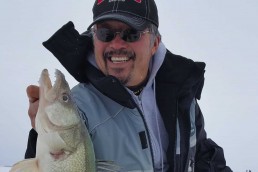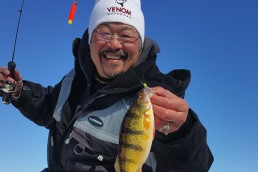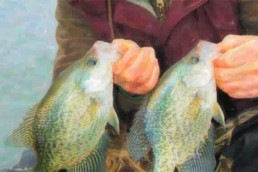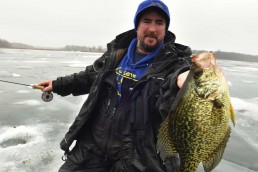Hone in on Spots, Fine-tune Presentation for Ice Success
SHARE THIS POST
Although small, many lakes hold fantastic numbers of big walleyes, jumbo perch, bluegills and huge crappies. Too much fishing pressure on some of these smaller lakes could damage the fishery. This means that heading to little-known, out-of-the-way lakes allows you to fish undisturbed without many power augers, too many baits in the water and too much confusion.
The lesson to this is to stay mobile. There’s a lot of water and the trick is to choose the right one.
It’s important to share information with a network of close friends who scout places to find active fish, although it is always best to be the one to discover the bite. And when ice fishing, it’s important to be prepared for any fish that’s active. Take a little tackle for everything and fish for anything that swims. Walleyes are great to go after at first, but northern pike pull hard and bite aggressively. Crappies, perch and bluegills are a blast to catch, and all are great for the frying pan.
Bring a variety of spoons in all sizes. Many anglers believe that they are only for catching walleyes or northerns, but you can catch any species of fish on these. The trick is to change the relative size of the spoon. A spoon’s flash is a great attractor. Fish on a suicide mission smash the whole thing, but most tend to be more neutral and need convincing in the cold water of winter. When fishing shallow water for bluegills, the reflection of a spoon on the underside of the ice is an added plus. Often, fish just look at a spoon unless it has a little added scent or food. Natural live bait will help too. You can even add a small plastic tail to a spoon as an attractor.
Instead of just aggressively ripping your spoon, try shaking it as well. The goal is having the hook dance around as the spoon sends off a flash. A medium-action rod like St. Croix’s Premier Ice with a tip on the stiffer side helps. If you have too light a rod, the rod tip will subvert your effort by not transmitting the action you want to the spoon. You can also watch the action of the spoon with an underwater camera in order to get the shake and action just right.
Are you enjoying this post?
You can be among the first to get the latest info on where to go, what to use and how to use it!
A trick you can try is to attach the smallest flicker blade you can to the split ring on top of a spoon. The combination of the spoon and flicker blade is a killer for walleyes, crappies and pike. Add a minnow head for walleyes or try a waxworm for really finicky fish; downsize your spoon for crappies and stick with waxworms. Maggots are excellent baits for ‘gills. Strikes can range from vicious to so subtle that all you will detect is an absence of weight on the line when a crappie takes it from below. Set the hook at any change in feel or rod tip vibration.
A graph, like Humminbird’s new Ice Helix 7, is a critical tool for catching fish. Watch your screen closely, as there are signs when you need to change presentations in color or action, especially if too many fish are looking at the lure but aren’t eating it.
Try using or dressing up jigs. Some anglers will use what’s called a “drop rig” featuring a spoon on top with a small jig on a dropper line below it. You can also put a small jig on the top with a Palomar knot and leave a 6- to 12-inch tag where you tie a spoon or slightly larger jig. The advantage to this rig is that you can fish more subtly—shaking it, and then stopping. Again, continue to watch your graph for fish. The spoon will “pin” the jig so its motion won’t spook fish.
Location
Presentation or tactics aren’t enough—location is important. For walleyes, look to the outer edges of classic walleye spots, like points and rock humps. The best depth depends on the lake. Some are 10 feet deep; some are 60 feet deep. The time of day plays a role as well. Walleyes cruise shallow flats early in the morning and return at night, though they may not be as shallow as before. Go deeper on structure during the day.
Many anglers will target deep crappies in 25 to 30 feet of water. Weeds that are 5 to 15 feet deep hold big crappies and bluegills all day long. Look for flats with big patches of coontail and milfoil, if these are present. Watch your spoon on your graph. Drop it down to the tops of the weeds. You can watch the crappies come up and take it. Weedlines are great for finding walleyes too. The best spots are differentiated by changes like slight turns, saddles, underwater weed points and other subtle changes such as bottom content and the weed variety. These are the “spot-on-the-spot” walleye locations often overlooked.
MWO
SHARE THIS POST
Did you enjoy this post?
You can be among the first to get the latest info on where to go, what to use and how to use it!
Ted Takasaki
Ted Takasaki is an International Fishing Hall of Fame professional angler who has been featured in many national outdoor magazines and television shows. Takasaki has appeared in front of thousands of angling enthusiasts and is considered one of America’s top walleye and multispecies anglers. Follow him on his Facebook page.



